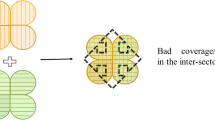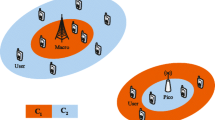Abstract
Vastly increasing capacity and coverage demand in communication networks accompanied by energy efficiency challenge is getting attraction in research topics of this area. In this paper, an improved structure of Phantom cell heterogeneous networks is proposed to fulfill these requirements in the next generation cellular networks. It will be shown that the proposed orthogonal frequency-division multiple access (OFDMA) based structure can be employed in both indoor and outdoor environments by applying two individual frequency bands. Furthermore, the resource allocation problem of the proposed structure is investigated in downlink path. To this aim, a proper algorithm is presented in order to maximize the total throughput of all phantom cell users’ equipments with regard to the protected minimum network capacity of the existing macrocell. To fulfill the objective goal, an iterative approach is employed in which OFDM subchannels and power transmitted by base stations are sequentially assigned and optimized at each step for every single frequency band. It is showed that the overall joint subchannel and power allocation algorithm converges to local maximum of the original designed problem. Performance improvement of the proposed algorithm is confirmed in both indoor and outdoor environments by numerical results.





Similar content being viewed by others
References
Cisco VNI Forecast. (2014). Cisco Visual Networking Index: Global mobile data traffic forecast update, 2013–2018. Cisco Public Information.
GPP RWS-120010. (2012). Requirements, candidate solutions & technology roadmap for LTE Rel-12 Onward. DOCOMO.
Marzetta, T. L. (2010). Non-cooperative cellular wireless with unlimited numbers of base station antennas. IEEE Transactions on Wireless Communications, 9(11), 3590–3600.
Ratasuk, R., Tolli, D. & Ghosh, A. (2010). Carrier aggregation in LTE-advanced. In Vehicular technology conference (VTC-Spring) (pp. 1–5).
Seifi, N., et al. (2014). Coordinated 3D beamforming for interference management in cellular networks. IEEE Transactions on Wireless Communications, 13(10), 5396–5410.
Parkvall, S., et al. (2011) Heterogenous network deployments in LTE. Ericsson Review, 2, 34–38.
Andrews, J., Claussen, H., Dohler, M., Rangan, S., & Reed, M. (2012). Femto-cells: Past, present, and future. IEEE Journal on Selected Areas in Communications, 30(3), 497–508.
Damnjanovic, A., Montojo, J., Wei, Y., Ji, T., Luo, T., Vajapeyam, M., et al. (2011). A survey on 3GPP heterogeneous networks. IEEE Wireless Communications, 18(3), 10–21.
De La Roche, G., Valcarce, A., Lopez-Perez, D., & Zhang, J. (2010). Access control mechanisms for femtocells. IEEE Communications Magazine, 48(1), 33–39.
Yun, J.-H., & Shin, K. G. (2011). Adaptive interference management of OFDMA femtocells for co-channel deployment. IEEE Journal on Selected Areas in Communications, 29(6), 1225–1241.
Chandrasekhar, V., Andrews, J. G., Muharemovic, T., Shen, Z., & Gatherer, A. (2009). Power control in two-tier femtocell networks. IEEE Transactions on Wireless Communication, 8(8), 4316–4328.
Bu, S., Yu, F. R., & Yanikomeroglu, H. (2015). Interference-aware energy-efficient resource allocation for OFDMA-based heterogeneous networks with incomplete channel state information. IEEE Transactions on Vehicular Technology, 64(3), 1036–1050.
Zhang, Haijun, et al. (2017). Sensing time optimization and power control for energy efficient cognitive small cell with imperfect hybrid spectrum sensing. IEEE Transactions on Wireless Communications, 16(2), 730–743.
Zheng, Wei, et al. (2014). Distributed power optimization for spectrum-sharing femtocell networks: A fictitious game approach. Journal of Network and Computer Applications, 37, 315–322.
Zhang, Haijun, et al. (2014). Resource allocation in spectrum-sharing OFDMA femtocells with heterogeneous services. IEEE Transactions on Communications, 62(7), 2366–2377.
Zhang, H., et al. (2012). Resource allocation with interference mitigation in OFDMA femtocells for co-channel deployment. EURASIP Journal on Wireless Communications and Networking, 2012(1), 289.
Iwamura, M., Etemad, K., Fong, M., Nory, R., & Love, R. (2010). Carrier aggregation framework in 3GPP LTE-advanced [WiMAX/LTE Update]. IEEE Commun Magazin, 48(8), 60–67.
Son, K., Lee, S., Yi, Y., & Chong, S. (2011). REFIM: A practical interference management in heterogeneous wireless access networks. IEEE Journal on Selected Areas in Communications, 29(6), 1260–1272.
Kishiyama, Y., Benjebbour, A., Nakamura, T., & Ishii, H. (2013). Future steps of LTE-A: Evolution toward integration of local area and wide area systems. IEEE Wireless Communications, 20(1), 12–18.
Ishii, H., Kishiyama, Y., & Takahashi, H. (2012). A novel architecture for LTE-B: C-plane/U-plane split and phantom cell concept. In 2012 IEEE Globecom Workshops (pp. 624–630). IEEE.
Zhang, Haijun, et al. (2015). Coexistence of Wi-Fi and heterogeneous small cell networks sharing unlicensed spectrum. IEEE Communications Magazine, 53(3), 158–164.
Zhang, Haijun, et al. (2016). Fronthauling for 5G LTE-U ultra dense cloud small cell networks. IEEE Wireless Communications, 23(6), 48–53.
Boyd, S., & Vandenberghe, L. (2004). Convex optimization. Cambridge: Cambridge University Press.
Geletu, A. (2007). Solving optimization problems using the matlab optimization toolbox-a tutorial. TU-Ilmenau: Fakultät für Mathematik und Naturwissenschaften.
Wong, C. Y., Cheng, R. S., Lataief, K. B., & Murch, R. D. (1999). Multiuser OFDM with adaptive subcarrier, bit, and power allocation. IEEE Journal on Selected Areas in Communications, 17(10), 1747–1758.
Bertsekas, D. P. (1999). Nonlinear programming. Belmont: Athena scientific.
Yu, W., & Lui, R. (2006). Dual methods for nonconvex spectrum optimization of multicarrier systems. IEEE Transactions on Communications, 54(7), 1310–1322.
Zhang, H., et al. (2012) Joint subchannel and power allocation in interference-limited OFDMA femtocells with heterogeneous QoS guarantee. In: Global Communications Conference (GLOBECOM), IEEE.
Author information
Authors and Affiliations
Corresponding author
Rights and permissions
About this article
Cite this article
Shahraki, H.S., Ajamgard, M. Improved phantom cell deployment for capacity enhancement. Wireless Netw 25, 157–166 (2019). https://doi.org/10.1007/s11276-017-1547-5
Published:
Issue Date:
DOI: https://doi.org/10.1007/s11276-017-1547-5




